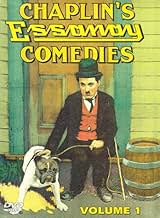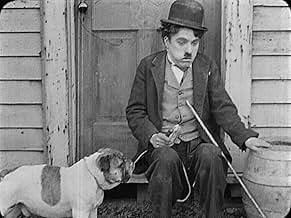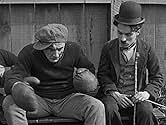Adicionar um enredo no seu idiomaWalking along with his bulldog, Charlie finds a "good luck" horseshoe just as he passes a training camp advertising for a boxing partner "who can take a beating." After watching others lose,... Ler tudoWalking along with his bulldog, Charlie finds a "good luck" horseshoe just as he passes a training camp advertising for a boxing partner "who can take a beating." After watching others lose, Charlie puts the horseshoe in his glove and wins. The trainer prepares Charlie to fight t... Ler tudoWalking along with his bulldog, Charlie finds a "good luck" horseshoe just as he passes a training camp advertising for a boxing partner "who can take a beating." After watching others lose, Charlie puts the horseshoe in his glove and wins. The trainer prepares Charlie to fight the world champion. A gambler wants Charlie to throw the fight. He and the trainer's daught... Ler tudo
- Direção
- Roteirista
- Artistas
- Bob Uppercut - Champion
- (não creditado)
- Enthusiastic Fan
- (não creditado)
- Sparring Partner
- (não creditado)
- Second Sparring Partner
- (não creditado)
- …
- First Sparring Partner
- (não creditado)
- …
- Second Stretcher Bearer
- (não creditado)
- Bit Role
- (não creditado)
- Bit Role
- (não creditado)
- Second Cop
- (não creditado)
- Sparring Partner
- (não creditado)
- Trainer's Daughter
- (não creditado)
- Bit Role
- (não creditado)
- Sparring Partner
- (não creditado)
- Ringside Vendor
- (não creditado)
- Spike Dugan
- (não creditado)
- Crooked Gambler
- (não creditado)
Avaliações em destaque
The set-up of an up-and-coming boxer who fights his way to the top, is then bribed into throwing a fight and has to choose between his integrity and the payoff was an established cliché even back then. This well-known sequence of events allows Chaplin to mess around with stereotypes or subvert conventions. For a start, there is the fact that Charlie is a scrawny little feller, who essentially cheats his way to the championship. Then there's the farcical training routine, which Chaplin cross-cuts with the opponents more serious routine to give it more comedy impact, followed by the tramp's nonchalant seeing-off of Leo White's over-the-top sinister villain.
Throughout Chaplin is showing more confidence in his staging and arrangements. He allows himself to become a more marginal figure in some sequences – for example when Spike Duggan is knocking out one challenger after another, Charlie isn't doing very much, and is off-screen half the time, but it's his reactions to the growing number of defeated men that is funny. The other characters simply act naturally, whereas Chaplin is the originator of all the comedy.
In Chaplin's previous picture, A Night Out, he came dangerously close to becoming a double-act with Essanay's resident comic Ben Turpin. A large part of Chaplin's humour was based on reacting to other comedy characters, so he needed to have his supporting cast of burly bullies and pompous twerps to antagonise. However in the Champion you can see he is being careful not to let any of them have too much screen time. Although Bud Jamison, Leo White and Ernest van Pelt all do a great job, each of them is a walk-on, walk-off character; none of them shares the picture with Charlie. Ben Turpin has a tiny part as a vendor, but even in this one-shot role he manages to violate Chaplin's rule of the tramp being at the comedic centre of attention, stealing the laughs as he scrambles over the crowd to reach a customer. This would be Turpin's last picture with Chaplin.
And now, we finish with the all-important statistic – Number of kicks up the arse: 1 (1 for, 0 against)
It begins with Charlie answering a prize-fighter's request for sparring partners, and starting from there Chaplin gets involved in some adventures that, though lacking any believability, are quite amusing. Most of the sequences make use of the secondary characters more than is usual for Chaplin's early features. Early in the story, while Charlie and the other fighters are waiting for their turn, it makes good use of the mannerisms and expressions of the others, as well as Chaplin himself. In the main fight scene, the activity in the ring is funny, creative, and well-choreographed - there are moments when it is almost as good as the celebrated boxing scene in "City Lights". That's not to say, of course, that overall this short movie approaches such a standard of greatness, but it is a well-made and entertaining little comedy.
I like quite a lot of the slapstick. Of course, there is nothing funnier than his boxing sequence in 'City Lights' (1931). Here he's trying out several things. When he's boxing fodder, he puts a horseshoe into his glove. Then during the long boxing match, he's doing a lot of what would recognizable to most people who's seen the boxing match in 'City Lights'.
I was so glad that this film was good. I was really disappointed with Chaplin's first two Essanay films His New Job and A Night Out. This is a real return to form. The idea was actually taken from a Fred Karno sketch that Chaplin performed before entering the movie industry. Perhaps one of the reasons for the film's success is that Chaplin knew what he was doing before he went in rather than partially making it up as he went along.
The film really shows its age with its inter-titles. There wasn't one occasion where I understood every word! But you have to remember that this film is 97 years old and language changes. Another thing that changes is people's attitudes and sensibilities towards kissing. It's hard to believe now but Hollywood once enforced a self censorship ruling that meant that no on screen kiss could last more than a couple of seconds. Although made in pre-code Hollywood, Chaplin got round this type of censorship by having his Tramp kiss Edna from behind a large beer bottle. It's a clever device that works around censorship.
The film is much slower and more measured than much of Chaplin's other work of the period and especially the work of Keystone. The opening scene in which Chaplin shares a hot dog with his equally starving dog is both very sweet and very slow and reminiscent of his later work. It's a complete opposite of his previous Keystone films.
The highlight of the film is undoubtedly the boxing. Watching Chaplin train in his trademark bowler hat is brilliant and the big fight itself is hilarious and extremely well choreographed. Chaplin and Jamison spend half the fight either falling over or in embraces, punching themselves in the face and the umpire obviously gets a few punches thrown his way too. Raging Bull this is not. You have to feel that the film is a precursor to Chaplin's massively successful City Lights which features his famous boxing scene. Another highlight is the fantastic makeup and over the top fake facial hair of the film's villain Leo White, a motif of Chaplin's early work. Without dialogue you are still always sure who the bad guy is with his deep dark eyes, pale face and enormous moustache.
This film is not up there with Chaplin's later work but shows great potential. It is a marked improvement on his earlier Essanay films and introduced a lot of action into his repertoire.
www.attheback.blogspot.com
Você sabia?
- CuriosidadesThe film was restored in 2014 through the Chaplin Essanay Project thanks to the financial support of the Niles Essanay Silent Film Museum.
- ConexõesEdited into Chase Me Charlie (1918)
Principais escolhas
Detalhes
- Data de lançamento
- País de origem
- Centrais de atendimento oficiais
- Idiomas
- Também conhecido como
- Charlie the Champion
- Locações de filme
- Empresa de produção
- Consulte mais créditos da empresa na IMDbPro
- Tempo de duração31 minutos
- Cor
- Mixagem de som
- Proporção
- 1.33 : 1
Contribua para esta página


































